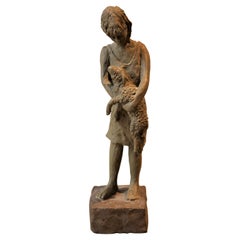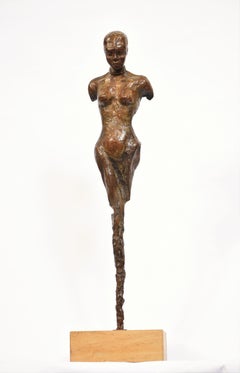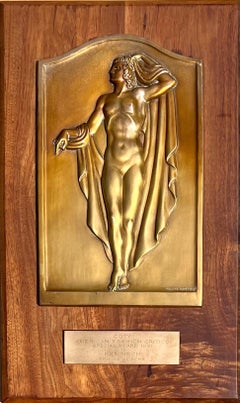Reeves Art + Design Nude Sculptures
to
7
4
1
2
Overall Height
to
Overall Width
to
1
1
5
5
4
3
2
2
1
1
1
5
2
1
1
1
1
4
4
1
1
1
Abstract Modernist Armless Female Nude Torso Bust Bronze Sculpture
Located in Houston, TX
Modernist nude bronze sculpture by Houston, TX artist David Adickes. The sculpture depicts an abstract armless female nude torse that stands on a wooden base. The piece is signed by the artist at the back of the sculpture's left leg.
Artist Biography: Born (1927) and raised in Huntsville, TX, David Adickes is an artist whose art and heart are closely aligned with Paris, France. After studying art at the Atelier F. Leger in the late 40s, Adickes burst onto the art scene in Houston and elsewhere in the early 50s and has been a prominent member of Houston’s art community ever since. While his most visible works are his giant sculptures, from the Virtuoso in downtown Houston...
Category
Early 2000s Modern Nude Sculptures
Materials
Bronze
Neoclassical Cupid Holding Fish Patinaed Bronze Fountain Sculpture
Located in Houston, TX
Bronze fountain sculpture of Cupid hold a fish. This beautiful bronze sculpture features intricate details and has a nice natural patina.
Category
Mid-20th Century Academic Figurative Sculptures
Materials
Bronze
“In The Pink” Abstract Modern Pantyhose Dimensional Female Form Wall Sculpture
Located in Houston, TX
Pastel pink toned post-modern wall sculpture made of pantyhose with a frosted lucite cover. The color and material are suggestive of the nude female form. Signed, titled, and dated o...
Category
Early 2000s Post-Modern Abstract Sculptures
Materials
Lucite, Mixed Media
Naturalistic Woman Holding a Calf Sculpture
Located in Houston, TX
Naturalistic sculpture of a woman standing and holding a small calf. The sculpture is signed "Happy Birthday 1976" and "W. R. Stevenson" on one side of the base.
Artist Biography: William Robert Stevenson was born in 20 May 1925 in Eugene, Oregon. His family moved to Minneapolis, MN but he promptly returned to Oregon and Washington during the Great Depression to work in the Works Progress Administration (WPA). Hoping to study Art, his future was sidetracked when he was drafted into the United States Army at age 17 years old in early 1942. Being a strong swimmer, and having worked at stables as a child, he initially served in the last US Cavalry Corps, and also as a Swimming Instructor for the United States Army. Upon the abolition of the Cavalry Corps, he was trained as a Gunnar and Tank Commander for the M-4 Sherman Tank under General Patton...
Category
20th Century Naturalistic Nude Sculptures
Materials
Plaster, Clay
"The Messenger" Gradient Bronze Mythical Sculpture 5 of 10
By Gil Bruvel
Located in Houston, TX
Mythical bronze sculpture of a fairy nude with ram horns. The bronze is two-toned. The fairy stands on a bronze geometric shaped pedestal. T...
Category
Late 20th Century Naturalistic Figurative Sculptures
Materials
Bronze
Figurative Grey Stone Sculpture of a Female
By Jose Zacarias
Located in Houston, TX
Figurative sculpture of a nude female figure. The stone is a grey tone with speckling. The artist signed and dated the piece in the crevice on the bottom. Jose Zacarias is known for ...
Category
1980s Abstract Impressionist Figurative Sculptures
Materials
Stone
20th Century Foumban Cameroon Bronze African Sculpture
Located in Houston, TX
Wonderful 20th Century Bronze African Sculpture of a warrior on a donkey from Foumban in Cameroon.
Category
20th Century Tribal Figurative Sculptures
Materials
Bronze
Related Items
Young Woman - Bronze Abstract Nude - Limited Edition
Located in Pretoria, ZA
Young Woman in bronze, abstract nude figurative bronze sculpture, limited edition of 24, height 64 cm including base, Sandstone base: approx 17 cm x 15 cm x 5 cm. Cast bronze using t...
Category
2010s Expressionist Nude Sculptures
Materials
Sandstone, Bronze
H 25.2 in W 5.91 in D 6.7 in
1961 Coty Award Plaque Kenneth Hairdresser Jacqueline Onassis Bronze Fashion
Located in New York, NY
1961 Coty Award Plaque Kenneth Hairdresser Jacqueline Onassis Bronze Fashion
Bronze on wood. The wood plaque measures 12 3/4" by 20 3/4 inches. The bronze plaque itself is 13 3/4 x 8 3/4 inches and the the bronze inscription, which reads "COTY, American Fashion Critics Special Award 1961 to KENNETH of LILY DACHE...
Category
1960s American Modern Figurative Sculptures
Materials
Bronze
Bronze Bust of Apollo Belvedere Grand Tour 19th Century
Located in Rochester, NY
Superb 19th century bronze and gilt bronze bust of the god Belvedere Apollo. Circa 1850. This wonderful grand tour bust is a marvel of refined beauty and elegance, crafted with richl...
Category
19th Century Figurative Sculptures
Materials
Marble, Bronze
Ian Edwards - Leap Within Faith - Original Signed Bronze Sculpure
By Ian Edwards
Located in Collonge Bellerive, Geneve, CH
Ian Edwards - Leap Within Faith - Original Signed Bronze Sculpure
Dimensions: 170 x 55 x 40 cm
Edition of 12
Edwards’ practice expresses the power and determination of human endea...
Category
2010s Contemporary Nude Sculptures
Materials
Bronze
H 66.93 in W 21.66 in D 15.75 in
Ian Edwards - Born within Fire - Original Signed Bronze Sculpure
By Ian Edwards
Located in Collonge Bellerive, Geneve, CH
Ian Edwards - Born within Fire - Original Signed Bronze Sculpure
Dimensions: 160 x 60 x 60 cm
Edition of 12
Edwards’ practice expresses the power and determination of human endeav...
Category
2010s Contemporary Nude Sculptures
Materials
Bronze
H 63 in W 23.63 in D 23.63 in
Sleeping Nude Large Wall Art
By Frank Gallo
Located in Lake Worth Beach, FL
Sleeping Nude
Large cast handmade paper, artist signed AP 10/20, 1981
62x52x5.5 wood, linen and lucite box frame.
Stunning art wall sculpture by Fran...
Category
1980s Modern Nude Sculptures
Materials
Lucite, Handmade Paper
Aurelia - One-of-a-kind Bronze Sculpture
By Nando Kallweit
Located in Los Angeles, CA
German sculptor Nando Kallweit produces figurative bronze sculptures and reliefs with aquiline and a graceful modern appeal. Kallweit is inspired by seemingly disparate cultures; the...
Category
21st Century and Contemporary Abstract Figurative Sculptures
Materials
Metal, Bronze
2 Sculptures: "The Power" & "The Glory" WPA Depression WWII era mid 20th century
By Agnes Yarnall
Located in New York, NY
2 Sculptures: "The Power" & "The Glory" WPA Depression WWII era mid 20th century by Agnes Yarnall circa 1940s.
Sculptor, painter, poet and artistic historian, Agnes Yarnall has, since the age of six been breathing life into her art.
Renowned as a sculptor, whose commissioned portrayals of contemporary celebrities are prized. She has sculpted Judith Anderson, Edna St. Vincent Millay, Carl Sandburg...
Category
1940s American Modern Figurative Sculptures
Materials
Plaster
Statue of Athlete: Large Academic Style Bronze Figurative Sculpture of Nude Male
By Mark Beard
Located in Hudson, NY
modern figurative bronze sculpture of a nude athlete
8.5 feet tall and measures 36 inches at the widest point
bottom base measures ...
Category
Early 2000s Academic Figurative Sculptures
Materials
Bronze
H 102 in W 36.5 in D 17.5 in
Elsie (7/25) - One-of-a-kind Bronze Sculpture
By Nando Kallweit
Located in Los Angeles, CA
German sculptor Nando Kallweit produces figurative bronze sculptures and reliefs with aquiline and a graceful modern appeal. Kallweit is inspired by seemingly disparate cultures; the...
Category
21st Century and Contemporary Abstract Figurative Sculptures
Materials
Metal, Bronze
Industrial Machine Age American Scene WPA Mid 20th Century 1939 SF World's Fair
Located in New York, NY
Industrial Machine Age American Scene WPA Mid 20th Century 1939 SF World's Fair
HAIG PATIGIAN (American/Armenian, 1876-1950)
Aeronautics Pediments
Two Plaster Casts, c. 1930s
each 13.25 x 14.75 x 6 inches
It's possible these moquettes were created for the 1939 World's Fair, the Golden Gate International Exhibition in San Francisco.
Provenance: Private Collection of Lois M. Wright, Author of "A Catalogue of the Life Works of Haig Patigian, San Francisco Sculptor, 1876-1950),” 1967
Loan to Oakland Museum of California (Oakland, CA)
BIO
Haig Patigian is noted for his classical works, which are especially numerous in public venues in San Francisco, California. Patigian was born in Van, Armenia, which at that time was under Turkish rule. Haig was the son of Avedis and Marine Patigian, both teachers in the American Mission School there. He and his older brother showed an aptitude for art early on and were encouraged by their parents. Their father himself had taken up the new hobby of photography. The 1880s were harsh times, however, for many Armenians under an oppressive rule by the Turkish government. Many people were fleeing to the safety of the United States. Suspicious Turkish authorities accused his father of photographing city structures for the Russian government, and in 1888 he fled for his life to America.
Haigs father made his way to Fresno, California, and began life anew as a ranch hand. Within two years he sent for his wife, as well as Haig, his three sisters and brother, and in 1891 the Patigians made the journey from Armenia. Haigs father, an industrious man, worked on various farms, and eventually bought his own ranch and vineyard. It was among fertile farmland of Fresno that Haig grew up.
Young Haigs education consisted of teachings by his parents and by intermittent attendance in public schools. Although he had dreams of becoming an artist, he did not have the opportunity for formal study of art, and began working long days in the vineyards around Fresno.
At age seventeen, Haig made a step towards his dreams and apprenticed himself to learn the trade of sign painting. In his spare time he nurtured his interest in art by painting nature and life scenes with watercolors and oil paints. When his sign-painting mentor left Fresno, Haig opened his own shop and made a name for himself in the town. San Francisco, in the meantime, had been attracting artists since the Gold Rush and had become a thriving art center. Within a few years, Haig had put aside several hundred dollars to move to San Francisco, joining his brother who was already working there as an illustrator.
In 1899, when he was twenty-three, Haig had saved enough money to enroll at the Mark Hopkins Art Institute in San Francisco. Like many aspiring artists of his time, Patigian supported himself by working as a staff artist in the art department of a local newspaper, and in the winter of 1900, nearing his 24th birthday, Haig began work for the San Francisco Bulletin, producing cartoons, black and white illustrations, as well as watercolors.
In 1902 tragedy struck Haig and his family. His 29-year-old brother died of pneumonia, and then his frail mother died a short time later. Five months more saw his youngest sister, just out of high school, die too. Saddened and depressed, Haig moved out of the studio he had shared with his brother, and into a dilapidated studio in a poor section of town. During this time of sadness, Haig fed a growing interest in sculpture.
In 1904 Haig created what he later called his "first finished piece in sculpture". The work, called "The Unquiet Soul", depicted a man thrown back against a rock while waves lash at his feet. The body was tense and twisted, with one hand, in Haig's own words, "searchingly leaning and clutching the rock, while the other masks his troubled head".
The Press Club of San Francisco, which Haig had joined in 1901, put "The Unquiet Soul" on exhibition and local headlines proclaimed "Local Newspaper Artist Embraces Sculptor's Art", and "First Work Predicts Brilliant Future". With the support of friends and community acclaim, the young illustrator left his newspaper job and became a professional sculptor.
The path of his new career was not easy though. Haig had never made much money working for the newspaper and his father needed help with growing debt from funeral expenses and business problems. From time to time Haig sold some artwork, but also occasionally borrowed from friends to pay the rent. He was the classic 'starving artist'.
In the spring of 1905 a white-bearded 81-year-old stranger knocked on Haig's door. It was George Zehndner, from Arcata, California. Zehndner had been born in Bavaria, Germany in 1824, the son of a farmer. In 1849 he had come to America looking for prosperity, settling in Indiana, where he worked on a farm and learned English. He found his way to the West Coast in 1852. Penniless, he worked in various jobs from San Francisco to Sacramento, then found some luck working in the gold fields of Weaverville in Trinity County, and eventually moving to a farm on 188 acres near Arcata. In his 77th year in May of 1901, Zahndner had taken a trip to San Jose, where he stood in a crowd to see a man he thought much of, President William McKinley. McKinley was popular as 'the first modern president' partially because he realized going out to meet the common person increased his support. In September of that year, however, an anarchist assassinated the president while he stood in a receiving line at the Pan-American Exhibition in Buffalo, New York. Soon after, the city of San Jose erected a statue of the slain president in St. James Park. Zehndner took a second trip to San Jose where he visited the McKinley monument. Touched, Zehndner decided that, no matter the cost, his town of Arcata too would memorialize McKinley.
George Zehndner had read about Haig in a newspaper article and asked if Patigian would create a heroic statue of the late President McKinley for Arcata. When asked how much it would cost, Haig responded, despite his borderline poverty, with the fabulous sum of $15,000. Zehndner agreed. The President was to be portrayed standing, wearing an overcoat, with his feet planted squarely on the ground. In the finished statue, one hand is held out before him in a typical posture of speaking, with the other hand holding the speech as his side. The 9-foot statue...
Category
1930s American Modern Figurative Sculptures
Materials
Plaster
"Pioneer Family" WPA American Modernism Plaster Maquette Realism 20th Century
By William Zorach
Located in New York, NY
"Pioneer Family," 23 1/2 x 16 1/4 x 10 3/4 inPlaster. c. 1927. Unsigned. Realism
The Smithsonian has a cast of this sculpture in its collection. Pictured on the cover of “The Sculpt...
Category
1920s American Modern Figurative Sculptures
Materials
Plaster



